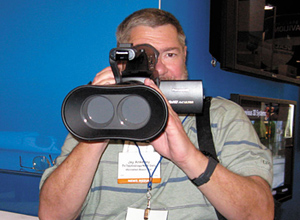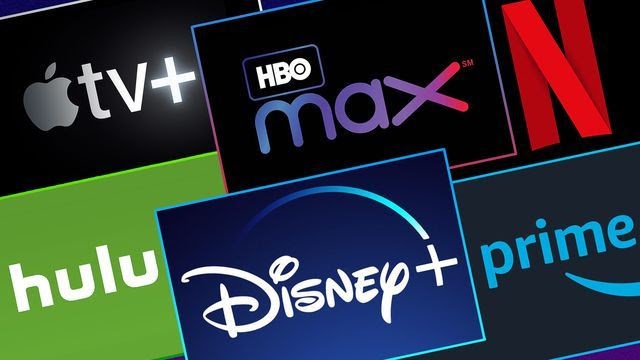The NAB Show Through An Editor's Mirror

The NAB Show is not only an annual opportunity for new product introductions and milestone industry announcements; it also serves as a snapshot of where our industry is and where it hopes to be going. So here is a bit of perspective from the post-production viewpoint about what on-site and virtual visitors can take away from the big show.
3D BUZZ
3D was, of course, all the buzz and the dauntless wizards at CineForm really pulled a rabbit out of their hat by unveiling their new Neo 3D editing workflow. A personal booth demo by CEO David Taylor revealed how this clever software lets you not only edit both the left and right eyes of a 3D project on a single timeline, but also—and this is the icing on the cake—adjust the two eyes' convergence and evaluate the resulting depth effect on a 2D editor's monitor by outputting the timeline to several common anaglyph formats.
Using simple two-colored lenses may not reveal the full color of a Z-space image, but it lets budget-squeezed editors evaluate and adjust the convergence of 3D clips before going to the expense of mastering a complete stereoscopic composite.
CineForm presented Neo3D on a Final Cut Pro NLE workstation. But Taylor tells us that by this month they should have released real-time Neo3D versions for Windows-based NLEs such as Sony Creative Software's Vegas Pro, and a Prospect3D engine for Adobe's Premiere Pro. I also have it on good authority that CineForm has been in discussion with Avid about an integrated workflow collaboration with Avid Media Composer and DS. This is a big step toward bringing 3D post to the masses.

Panasonic's proposed "3D full HD camcorder" with fixed interocular lens configuration Panasonic gave us a glimpse of their proposed "3D Full HD Camcorder" and I was given the privilege of being one of the first to get my hands on it. Neither its official name nor price has been set yet, but as you can see it's in a single camera body with a fixed interocular distance between the lenses so it should cost far less than the elaborate dual-camera digital cinema 3D rigs most of the big studios are using today.
AVID RETURNS
Avid was heartily welcomed back to the NAB fest, and their main message from Gary Greenfield, Avid's chairman and CEO, was that they were there "with all five of our entities (Avid, Digidesign, M-Audio, Pinnacle Systems and Sibelius) coming together as a unified identity that is Avid."
But for working Avid editors, one of their biggest announcements came six weeks before the 2009 NAB Show with the release of version 3.5 software for Avid Media Composer and Symphony systems.
Angus Mackay, Avid's professional segment marketing manager, tells us, "The new 3.5 software will change an editor's life."
According to Mackay, a major feature of 3.5 is a new plug-in architecture called Avid Media Access (AMA) that now provides native support for Panasonic P2 (DVCPRO/50/HD), 10 bit AVC-Intra 100/50 (MPEG-4/ H.264 HD), Sony XDCAM HD (long GOP HD in MPEG-2) and the RED r3d file format.
"Avid has done the work to let our systems import different camera file formats in a much more timely fashion, thanks to the AMA plug-ins," he says. "Since Media Composer is the most popular professional editing system in the world, the ability to work natively with SD, HD, Long GOP or I-frame in any format and directly access their media is one of the greatest strengths of the 3.5 release."
Version 3.5 also brings with it the ability to acquire, edit and view stereoscopic 3D material on a true 3D display, keyframeable color correction, and a new Fluid Stabilizer to track and remove camera motion when used in combination with the Avid SteadyGlide feature.
MISSING PLAYERS
A few of the post-production players were absent from the Las Vegas scene, but you still may be interested in what they have been up to. Last November, Apple released version 6.0.5 of Final Cut Pro, which gave it improved workflow support of the RED camera's raw r3d files without transcoding.
Richard Townhill, Apple's director of video applications marketing, tells us FCP was all over the NAB Show.
"Final Cut Pro has generated its own post-production ecosystem," Townhill sawith JVC's new GY-HM100 camcorder that records to the native FCP Quicktime format, AJA's Ki Pro digital disk recorder that stores images in ProRes and, of course, Neo 3D from CineForm."
Townhill would also like those basking in the afterglow of the show to know that a recent report from the market research firm SCRI revealed, "50 percent of the new nonlinear editing systems purchased in the U.S. broadcast and professional post-production video marketplace over the last 12 months were Final Cut Pro."
Quantel, whose mega-processing post-production systems are involved with an increasing number of high-end HD and digital cinema releases, would also have liked to exhibit, and as their head publicist, Roger Thornton, explains, "It would have been a show of consolidation and developments across our range of products."
This would have included the launch of Marco 2, the second generation of their laptop edit system, which takes the Quantel editing interface on the road, complete Final Cut Pro integration in Quantel systems, and version 4.1 software, which would have been the backbone of all Quantel's "new stuff on show, which has brought multiple new features to eQ, iQ and Pablo," as Thornton put it.
AUTOSTEREOSCOPIC
Finally, it is hard to overestimate the potential significance of the real-time moving hologram seen at Japan's National Institute of Information and Communication Technology (NICT) booth in the North Hall. But among the other dazzling exhibits they presented was the best autostereoscopic (glasses-free) display I've seen. Early autostereoscopic screens for digital signage presented under 11 left/right "views," and Philips had more recently upped the ante to 46 views with their 56-inch WOWvx LCD screens.
NICT showed convention-goers their own glasses-free display, said to present over 70 views. But it still was not a screen on which I would want to watch a long-form program. As improved as it was, even NICT's autostereoscopic leap forward did not dispel concerns that mainstream glasses-free 3D may prove as unattainable as getting stereo audio out of a single speaker.
Who knows? Maybe next year.
Jay Ankeney is a freelance editor and post-production consultant based in Los Angeles. Write him at 220 39th St. (upper), Manhattan Beach, Calif. 90266 or atJayAnkeney@mac.com.
Get the TV Tech Newsletter
The professional video industry's #1 source for news, trends and product and tech information. Sign up below.
